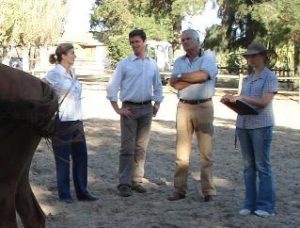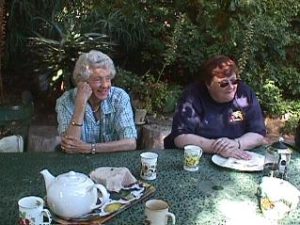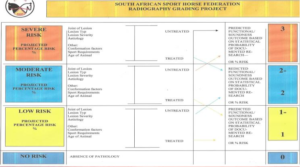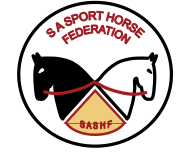About Us
The SASHF was registered with the South African Stud Book in March 2004, following discussions and approval by the registrar for livestock Improvement, Dr Keith Ramsay and Mr Charl Hunlun, the director of the SA Studbook.
In keeping with the requirements of the Animal Improvement Act, all SA Studbook affiliated Breed societies are required to register their member’s animals with this Body.
Accordingly, the South African Sport Horse Register (code ZAH) was opened early in 2004.
This is the question we are commonly asked. In short, the breeding goal of the SASHF is the development of an athletic sport horse based on phenotype and not genotype.
In other words, the breed register is not based on any particular genetic breed profile, but rather n the production of an athletic sport horse type.
Underlying this breed philosophy is, therefore, the acceptance that various crossbreed mixtures produce successful competition horses for a range of South African and international Sport purposes – and that specific crosses have proven ideally suited to particular disciplines.
In the South Africa equestrian world this can be seen, for example, in the arab, arab/cross, boerperd horses which specialize in Endurance; the hackney tyes which are well suited to harness; the thoroughbred and thoroughbred crosses which excel in polo, polocrosse and eventing. These developments are also completely aligned with international sport horse trends and statistics in the past decade, both in terms of the formation of similar sport horse registries world wide, as well as the success of these “cross breed” Sport Horses in the international arena.
For example. The Irish Sport Horse (heavy draught crossed with thoroughbred) is consistently represented in the top world rankings for eventing, as is the British and New Zealand Sport Horse.
These mixtures also perform well in Show Jumping.
As the Sport Horse trend developes, we consistently see different countries’ “ Sport Horse” representatives coming into the picture, for example the Italian and Iberian Sport Horses from Spain and Portugal.
Again, in keeping with these international breed trends, the foundation breeds listed in the SASHF breed register includes: Arab, Nooitgedacht, Friesian, Boerperd, Appaloosa, Spotted Sport Horses, Highlands Sport horses, Irish Sport Horses, Clydesdale, Percheron, Thoroighbred, Andelusian, Warmblood, Quarterhorse, Lipizzaner, Welsh and American Saddler.
In the twelve years since it’s inception, the formalization of the SA Sport Horse studbook, has provided a registration base for the various cross breeds listed above, and in truth, motivated some “new”, super specialist breed programs, for example; the highland Sport Horse, (Clydesdale/Thoroughbred cross), the Pegger Pony breed programe for gymkhana and childres sport, super specialist Polo and Endurance Studs – to name but a few developments.
In Practical terms, therefore, a South African Sport Horse is considered to be a horse of mixed breed which conforms to a certain physical type, for sport and competition purposes, this “type” require the animal to be:
- Basically correct in conformation according to specified criteria on inspection.
- Supple, elastic and athletic in movement and gait to enable performance success.
- Demonstrate good quality and breed type.
- Possess a good temperament and be easily workable.
- Be in possession of three good paces.
- Comply with fertility standards (not applicable to Geldings)
To summarize in practical terms, a South African Sport horse is eligible for registration as a South African Sport Horse if:
- It is of mixed (composite) breeding resulting from the above foundation breeds and meets the criteria in terms of physical type and ability, or
- Is of mixed, unknown parentage, but meets the Sport horse criteria in terms of physical type and ability, and
- Is not recorded in any other breed category with SA Studbook.
- The animal is approved for SA Sport Horse breeding purposes, and will be designated as such on the SA Sport Horse Breed registry with the SA Studbook.
Any questions in this regard. Or if any person has any queries about a specific horse’s eligibility – please do not hesitate to contact the SASHF office, who will be only too willing to assist with information.
SOUTH AFRICAN SPORT HORSE BREED PROGRAMS AND COMPETITION PERFORMANCE
SASHF Stud Book has progressed to fourth and fifth generation in certain of its Olympic Discipline breed programs. Other younger Sport Horse breeding programs for other disciplines are in their second and third generation, and progressing well.
In the competition arena, SA Sport Horses have performed well at National and International (FEI level) Competitions, including: winner of FEI Young Horse Championship for our World Division 2013, winner of FEI 4 year old Young Horse Dressage Championship 2013, Winner Champion Youngstock Autumn Classic, Champion Youngstock General Breed Horse of the Year 2014. SA Sport Horses are competing at Advanced Dressage level, showjumping 1m30 and 1m40 classes, and also winning in the show arena nationally.
2014 saw the first large scale co-ordinate SA Sport Horse Cross Breed program with the Nooitgedacht Society. This involved the limited (2 year) opening of the Nooitgedacht Stud Book to the SASHF modern Lusitano Stallion Sabio, in a breed program designed to produce a Nooitgedacht Sport Horse. 10 of 14 mares confirmed in foal as a result of a well co-ordinate Artificial Insemination pro- gram.
In excess of 20 horse have been approved for import through the SASHF Studbook since its formation.
National Inspection of 169 horses. The second National Inspection with an International Inspectorate took place in 2007 with Visiting Ex- pert Bento Castelhano from Portugal. Collec tively, 40 horses were evaluated. In addition, numerous other smaller scale Inspections have taken place around the Country. A new preliminary Stallion Classification (Prospective Stallion) was introduced for Inspections, which pro- vided breeders/owners with the opportunity to “pre-screen” potential Stallion candidates as early as age 2 years.


SASHF Inspectors have also undergone extensive international training, and we are grateful to Ms Jinny Martin who independently undertook to train and develop her personal knowledge further in the UK , Denmark and Germany, as did Ms Cilla Dugmore. Caron Potocnik and Jinny Martin also attended Grading training in Germany.
This project set out to encourage clinic pro grams with visiting International Trainers in Dressage, Showjumping and Eventing. More specifically, regular Dressage Clinics with Mr Jorge Pereira from Portugal were co-ordinated in Johannesburg and Cape Town, and 7 such seminars were held during the period 2003-2005.
Other International Experts brought to South Africa as part of this project during 2003 to date included: Tanya Larrigan (Dressage, Eventing and Horsemanship 2004), Jorge Sousa (2007) and in excess of 20 seminars by German FN registered Reitlehrer Mr Helmut Wagner (Dressage, Showjumping and Eventing). Every effort has been to consolidate this classical training in both the practical (riding) as well as theoretical sphere of education, and towards this end theoretical training notes have been formalized and distributed at seminars. These are currently in the process of presentation for formal publication in book form.
Some SASHF officials have participated in the Grow Grand Prix Dressage Program with Dutch Olympian Rien van der Schaft since 2012. Plans for 2015 include coordinating satellite clinics for young developing riders in order to extend this knowledge. 2014 saw the formation of the exciting Classical Equitation subcommittee under the expert guidance of Karin Blignault, and the first of these assessment events is scheduled for March 2015 in the Western Cape.
This committee focused on bringing a scientific orientation to South African Sport Horse Breeding and Performance evaluation. This committee has per- formed very important work with:
- The formulation of the first Olympic Discipline Performance Grading system. Hence horses are not evaluated on conformation (linear criteria) only, but earn grading status on the basis of personal and progeny performance. This practical system literally tests con- formation anomalies on the rational basis that conformation anomalies should not harshly discriminate against an animal when this does not seriously hamper performance. Performance at the end of the day, being the primary objective of Sport Horse Breeding.
- Visiting International Experts This included the lecture tour of Professor Eric Barrey, the world Expert in Equine Kinetics (in combination with the SA Jockey Club), during which time he demonstrated his Equimetrix locomotion evaluation system for horses. This system and its software is designed to document a movement profile for the Sport Horse, (for jumpers and dressage horses), which can then be evaluated in comparison to the normative database of 5000 Hanoverian horses – this being justifiably selected as the primary Sport Horse Stud book in the world. SASHF is fortunate that an Equimetrix system was purchased in 2012, and this is available for SASHF evaluations. The goal is to compile a database of Equimetrix evaluations for all SASHF licensed stallions, (and further their progeny for future research regarding heritability factors in movement).
- Preliminary work towards a Radiography Grading system for Sport Horses. This work is ongoing in association with expert Veterinarians, and in short, (based on long term follow-up studies and out- come measures for orthopedic lesions) aims to provide a risk schedule for pre-purchase vet assessments incorporating conformation, bone and soft tissue lesion variables such as location and severity of lesion and treatment prognosis.

Statistical Analysis of important Thoroughbred pedigrees for Showjumping is ongoing with an approximate 40 year record established and data collection ongoing to bring this to current status. v) Annual Performance Ranking System for Stallions, broodmares and their progeny, Vi) Veterinary based seminars have also been negotiated with specialist veterinarians, and aside from the lecture platform – this information will be available in written or electronic note form.
Community Development Project mainly under the superb leadership of Wendy Elliott until 2011 saw excellent assistance and education provided to underprivileged communities and their horses. This took the form of collating used and new donations (medication and saddlery equipment). An industrial sewing machine was acquired for an Overberg Community and many people were trained in basic medical care of horses, leather sewing, repairs and making of soft saddlery items. An industrial sewing machine was also acquired for an Overberg community.
- Firstly, despite the exciting and good developments achieved in early years, it is important to acknowledge shortcomings. Solving these difficulties is necessary for optimal strength and growth of the Federation in the future. These have definitely been in the area of administration and horse recording. SASHF is in the process of formalizing an office with a structured secretariat (we welcome Marike Kotze Masters degree Genetics), as opposed to voluntary administrators who have not managed to keep up with growing work demands as the Stud Book developed. Some serious challenges have also been encountered within the Dept Agriculture, and these will hopefully be resolved in the near future.
- This year, the Inspection Committee aims to formalize the Inspector Training Program and examination system, inclusive of International Training opportunities and international accreditation. Several International Sport Horse Bodies have pledged assistance with Inspector Training.
- Formalizations of 3 level Horse “examination “ system to provide certification at various levels of you horse in hand and early performance work. This would e.g. have commercial sale value if the horse is assessed and certified to be good and safe to handle with respect to shoeing, boxing, lunging and specified in hand work.
- Establishment of a regular i) National and ii) International (Visiting Expert) Inspection program and Stallion Grading. The Electronic Inspection system was initiated in 2013 for the National Grading section of the SA Sport Horse Stud Book. Specific requirements for the photographic and video material were established, and it was found i) that breeders were accurate and compliant with regard to requirements, ii) the electronic (photographic/video) inspection platform is viable and functional. Rien van der Schaft has agreed to work with SASHF in the capacity of an International Inspector, and is also willing to utilise this electronic process in a trial run for our International Inspections.
- Finalization of Statistical structure of the Performance Database in conjunction with SA Stud Book.
- Completion of the Radiography project
- Formation of Import/Export Committee
- Establishment of Education Committee and related certification Seminar Program. Lecture topics and treatment for the most important diseases and syndromes encountered by the horse owner, for 2015 will be 1) “Basic First Aid for the Horse”. This seminar will cover first line symptoms. 2) “The Breeding Process”.
- Establishment of Education Committee and related certification Seminar Program. Lecture topics for 2015 will be 1) “Basic First Aid for the Horse”. This seminar will cover first line symptoms and treatment for the most important diseases and syndromes encountered by the horse owner, 2) “The Breeding Process”.
- Fundraising. The goal of fundraising is to generate income for SASHF related services and events (primarily National and International Inspection costs, as well as National and International Trainer seminar fees), in order to assist the financial burden placed on members. A fund raising system will be established, incorporating i) basic import/export levies, ii) seminar levy fees, iii) Stallion service donations, iv) formation of an online “shop” platform for the sale of various horse and rider-related products . It is hoped that the online shop will also provide members with the benefit of marketing their own equestrian related business products and services, vi) formalizing electronic advertising plat- forms, and vii) other event projects.
- Stallion Project: This project incorporates the annual donation of semen by stallion owners. A nominal fee will be charged for the benefit of the Society, also providing members with an affordable opportunity for cross-breeding with good quality stallions.
- Application has been made to co-ordinate Inspector Training with several international organizations. This international accreditation will be the first of its kind in South Africa, and provide SA Students with the opportunity for international qualifications when successfully completing an international training and examination process.
- Ongoing research: University based Genetics Departments will be collaborating with the statistical analysis of the Thoroughbred Showjumping pedigree project.
- Karin Blignault has initiated the Classical Riding and Training Project, and the first Assessment event for this program is scheduled for March 2015, Western Cape.
- The initiation of the Electronic show system, which will allow SASHF Breeders and owners to compete their horses through an online video based system. A SA Sport Horse Championship that will accommodate foals and mature horses of all ages, with in hand and ridden class categories, is scheduled utilising National and International Judges.
- The Community Education Program will proceed, with the goal of extending its reach to larger parts of SA Horse Communities in need of this development. This will form the base of the “HOOFPRINT” system (areas incorporated being considered as “Hoofprint” regions) – the latter being a metaphor for the extending horse trail influence that SASHF aims to generate. This will take the form of i) collation of used, new or broken tack and dispersal to areas of need. Ii) training of people in repair / sewing skills, iii) Hoof Care Project: A farrier has agreed to design and ad- minister a three-level course in hoof care in underprivileged communities, namely a) basic hoof knowledge and care, b) trimming hooves, c) basic shoeing, d) making of shoes and other metal crafts.
- Develop SASHF Member benefits: Upgraded website and facebook advertising opportunities for SASHF breeder members and stallion owners.
- Formation of the Provincial Arms of SASHF, initiated with meetings in each region.
- Application for membership of the Olympic Discipline Section of the SASHF Stud Book with World Breeding Federation for Sport Horses (WBFSH) by August 2015.
- Close liaison with Veterinary bodies in matters of horse health and South African policy and legislature. The SASHF Facebook page will be the electronic interface for communication on these matters.
In closing, it can be seen that much has been achieved since the formation of SASHF in 2004. It is also clear that many areas of the organization functioning still require considerable improvement.
We welcome thoughts, comments and suggestions by members to assist with future progress. Above all, we remind you that SASHF belongs to its members, and we encourage all members to be actively participant in this exciting and rapid growth process of your Federation. Let us work together to make this an organization that is valuable to all in terms of communication, education and general assistance in breeding and performance matters – and at the same time – let us make it a pleasure for all involved to be part of the process.
